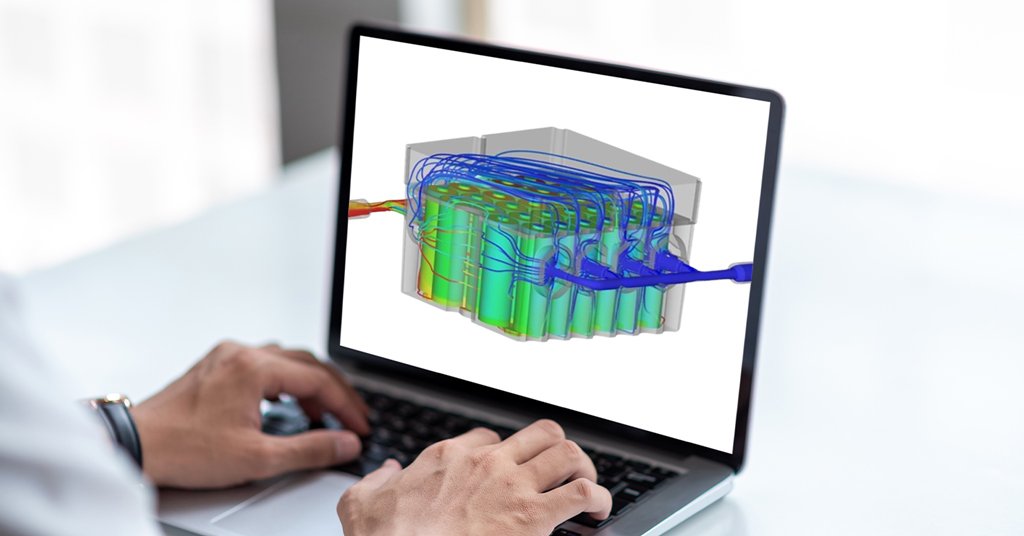Computational Fluid Dynamics (CFD) services can play a crucial role in the design of better electric vehicle (EV) battery and thermal management systems. It is a simulation-based approach that uses mathematical algorithms to model and analyzes the fluid flow and heat transfer. By using CFD services, engineers predict the performance of a design before it is built, which allows for the optimization of the design before it is manufactured.
One of the major areas where CFD services can be used in the design of EV batteries is in the analysis of the thermal management system. In this article, we will explore how CFD services improve the efficiencies, safety, and longevity of EV batteries and thermal management systems.
Design Optimization of EV Batteries and Thermal Management Systems with CFD Services
Designing an electric vehicle (EV) battery is a complex task involving balancing several factors, such as cost, energy density, safety, and thermal management. Here are two major challenges faced in the process:
1. Ensuring Battery Efficiency
One of the biggest challenges in designing EV batteries is ensuring that the battery operates efficiently and safely over a wide range of temperatures. As the battery is charged and discharged, it generates heat, and if the heat is not dissipated effectively, it leads to reduced battery performance and even failure.
2. Preventing Premature Battery Degeneration
Another major challenge in designing EV batteries is ensuring that the battery operates extensively without degradation. As the battery ages, its capacity and performance degrade, reducing the vehicle’s range and performance. Engineers need to design batteries that can maintain a high level of performance over a long time.
CFD Analysis as a Problem Solver
CFD can be used to sort out these challenges by providing simulations that allow engineers to predict the thermal performance and behavior of a battery before it is built. CFD simulations predict how the battery’s temperature will change under different operating conditions and how the heat generated by the battery will be dissipated to the surrounding environment. This information can be used to optimize the design of the battery’s thermal management system, such as the placement and size of cooling fins and the coolant flow.
CFD simulations also indicate the battery’s performance over its lifetime. Engineers can use it to model the battery’s aging and predict how its capacity and performance will degrade over time. This information helps optimize the design of the battery to ensure that it maintains a high level of performance over a long period.
Additionally, CFD simulations assist in analyzing the thermal performance of the entire electric vehicle, including the battery, the motor, and the inverter. Engineers utilize this information to optimize the design of the thermal management system to ensure that all components operate within safe temperature limits.
CFD Process in Design Optimization of EV Batteries
The process of using Computational Fluid Dynamics (CFD) to optimize electric vehicle (EV) battery design and thermal management typically involves the following steps:
1. Geometry Creation And Meshing
The first step is to create a digital model of the EV battery and thermal management system, including all relevant components, such as the battery pack, cooling fins, and coolant channels. This model is then meshed, dividing the model into small, manageable elements for which the CFD software can solve equations.
2. Problem Setup And Boundary Conditions
The next step is to set up the CFD problem, which involves defining the type of simulation to be run (such as steady-state or transient) and specifying the initial and boundary conditions. For example, the initial temperature of the battery and the surrounding air, the coolant flow rate, and the heat flux on the cooling fins.
3. Solving The CFD Equations
Once the problem is set up, the CFD software uses mathematical algorithms to solve the equations that govern fluid flow and heat transfer. This process typically takes a significant amount of computational power and can extend from several hours to several days, depending on the complexity of the problem.
4. Post-Processing And Data Analysis:
After the CFD equations are solved, the resulting data is post-processed to visualize and extract useful information. Engineers use this data to analyze the performance of the EV battery and thermal management system under different operating conditions. This includes calculating temperature distributions, heat fluxes, fluid velocities, and pressure.
5. Design Optimization
Based on the results of the CFD simulation, engineers iteratively optimize the design of the EV battery and thermal management system. Besides that, adjusting the geometry of the battery pack, cooling fins, and coolant channels ensure that the heat generated by the battery is dissipated effectively. This phase facilitates optimizing the layout of the cooling systems and evaluating the effectiveness of different cooling methods.
6. Validation
Finally, the optimized design can be validated by running additional CFD simulations or performing experimental tests on the physical prototype. This allows engineers to ensure that the design meets the required performance and safety standards.
We must note that this process is iterative. It is common practice to make changes in the design and rerun simulations until the desired thermal management system, and battery design is achieved.
Summing Up
CFD services play a crucial role in the design of better EV battery and thermal management systems. By using CFD simulations, engineers are able to predict the performance of a design before it is built, which allows for optimizing the design before it is manufactured. This can lead to more efficient, reliable, and longer-lasting EV batteries and thermal management systems.
With the increasing popularity of electric vehicles, deploying reputed CFD services could become increasingly essential to ensure that these vehicles meet the required performance and safety standards.
Mechartes has over 15 years of experience providing CFD services for over 5000 projects. Our team of leading CFD experts offers accurate and reliable CFD services for EV battery design and thermal management to meet your business requirements.
Talk to our experts to know more!


 Share
Share  facebook
facebook